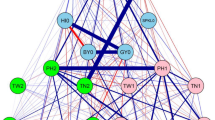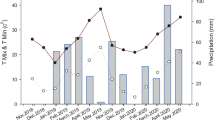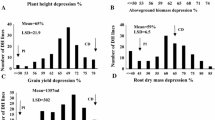Abstract
Low market prices and environmental concerns in Europe favor lower input wheat production systems. To efficiently breed for new varieties adapted to low input management while maintaining high yield levels, our objective was to characterize the heritability and its components for yield and nitrogen traits under different nitrogen levels. Two hundred and twenty-two doubled-haploid (DH) lines from the cross between Arche (tolerant) and Récital (sensitive) were tested in France at four locations in 2000, and three in 2001, under high (N+) and low (N−) nitrogen supplies. The response of yield to the environment of four probe genotypes, the parents and two controls, were tested and used as descriptors of these environments. Grain yield (GY), its components, and grain and straw nitrogen, called nitrogen traits, were studied. A factorial regression was performed to assess the sensitivity (slope) of the DH lines to nitrogen stress and their performance to low nitrogen supply. An index based on the nitrogen nutrition index at flowering of the probe genotype Récital was the best descriptor of the environment stress. Heritabilities of yield and nitrogen traits for both nitrogen supplies were always above 0.6. When nitrogen stress increased, heritabilities decreased and genotype × nitrogen interaction variances increased. The decrease in heritability was mainly explained by a decrease in genetic variance. Genetic variation for sensitivity to nitrogen stress and performance under low nitrogen supply were shown in the population. GY decreased from 278 to 760 g/m2 per unit of nitrogen stress index increase and GY under moderate nitrogen stress varied from 340 to 613 g/m². Those contrasted reactions revealed specific lines to include in breeding programs for improving GY under low nitrogen supply.


Similar content being viewed by others
References
Agrama HAS, Zakaria AG, Said FB, Tuinstra M (1999) Identification of quantitative trait loci for nitrogen use efficiency in maize. Mol Breeding 5:187–195
Bänziger M, Betran FJ, Lafitte HR (1997) Efficiency of high-nitrogen selection environments for improving maize for low-nitrogen target environments. Crop Sci 37:1103–1109
Bertin P, Gallais A (2000) Genetic variation for nitrogen use efficiency in a set of recombinant maize inbred lines. I. Agrophysiological results. Maydica 45:53–66
Brancourt-Hulmel M, Heumez E, Pluchard P, Beghin D, Depatureaux C, Giraud A, Le Gouis J (2005) Indirect versus direct selection of winter wheat for low input or high input levels. Crop Sci 45:1427–1431
Brancourt-Hulmel M, Denis JB, Lecomte C (2000) Determining environmental covariates which explain genotype environment interaction in winter wheat through probe genotypes and biadditive factorial regression. Theor Appl Genet 100:285–298
Brancourt-Hulmel M (1999) Crop diagnosis and probe genotypes for interpreting genotype environment interaction in winter wheat trials. Theor Appl Genet 99:1018–1030
Brancourt-Hulmel M, Lecomte C, Meynard J (1999) A diagnosis of yield-limiting factors on probe genotypes for characterizing environments in winter wheat trials. Crop Sci 39:1798–1808
Calhoun DS, Gebeyehu G, Miranda A, Rajaram S, Vanginkel M (1994) Choosing evaluation environments to increase wheat-grain yield under drought conditions. Crop Sci 34:673–678
Campbell BT, Baezinger PS, Gill KS, Eskridge KM, Budak H, Erayman M, Dweikat I, Yen Y (2003) Identification of QTLs and environmental interactions associated with agronomic traits on chromosome 3A of wheat. Crop Sci 43:1493–1505
Denis JB (1988) Two-way analysis using covariates. Stat 19:123–132
Dumas JBA (1831) Procédés de l’analyse organique. Ann Chim Phys 2:198–213
Félix I, Loyce C, Bouchard C, Meynard JM, Bernicot MH, Rolland B, Haslé H (2002) Associer des variétés rustiques à des niveaux d’intrants réduits. Intérêts économiques et perspectives agronomiques. Persp Agric 279:30–35
Finlay KW, Wilkinson GN (1963) The analysis of adaptation in plant-breeding programme. Aust J Agric Res 14:742–754
Holland JB, Nyquist W, Cervantes-Martinez C (2003) Estimating and interpreting heritability for plant breeding: an update. Plant Breed Rev 22:9–112
Justes E, Mary B, Meynard J-M, Machet J-M, Thelier-Huche L (1994) Determination of a critical nitrogen dilution curve for winter wheat crops. Ann Bot 74:397–407
Lacaze X, Roumet P (2004) Environment characterisation for the interpretation of environmental effect and genotype × environment interaction. Theor Appl Genet 109:1632–1640
Lamkey KR, Hallauer AR (1987) Heritability estimated from recurrent selection experiments in maize. Maydica 32:61–78
Le Gouis J, Béghin D, Heumez E, Pluchard P (2000) Genetic differences for nitrogen uptake and nitrogen utilisation efficiencies in winter wheat. Eur J Agron 12:163–173
Le Gouis J, Jeuffroy MH, Heumez E, Pluchard P (1998) Différences variétales pour le fonctionnement du blé tendre en conditions de nutrition azotée suboptimales. In: Maillard P, Bonhomme R (eds) Fonctionnement des peuplements végétaux sous contraintes environnementales. INRA Editions (Les colloques, n 93), pp 531–538
Leterme P, Manichon H, Roger-Estrade J (1994) Analyse intégrée des rendements du blé tendre et de leurs causes de variation dans un réseau de parcelles d’agriculteurs du Thymerais. Agronomie 14:341–361
Loudet O, Chaillou S, Krapp A, Daniel-Vedele F (2003) Quantitative trait loci analysis of water and anion contents in interaction with nitrogen availability in arabidopsis thaliana. Genetics 163:711–722
Presterl T, Seitz G, Landbeck M, Thiemt EM, Schmidt W, Geiger HH (2003) Improving nitrogen-use-efficiency in European maize: estimation of quantitative genetic parameters. Crop Sci 43:1259–1265
Presterl T, Groh S, Landbeck M, Seitz G, Schmidt W, Geiger HH (2002a) Nitrogen uptake and utilization efficiency of European maize hybrids developed under conditions of low and high nitrogen input. Plant Breed 121:480–486
Presterl T, Seitz G, Schmidt W, Geiger HH (2002b) Improving nitrogen-use efficiency in European maize—comparison between line per se and testcross performance under high and low soil nitrogen. Maydica 47:83–91
Quarrie SA, Steed A, Calestani C, Semikhodskii A, Lebreton C, Chinoy C, Steele N, Pljevljakusic D, Waterman E, Weyen J, Schondelmaier J, Habash DZ, Farmer P, Saker L, Clarkson DT, Abugalieva A, Yessimbekova M, Turuspekov Y, Abugalieva S, Tuberosa R, Sanguineti M-C, Hollington PA, Aragués R, Royo A, Dodig D (2005) A high-density genetic map of hexaploid wheat (L.) from the cross Chinese Spring × SQ1 and its use to compare QTLs for grain yield across a range of environments. Theor Appl Genet 110:865–880
SAS Institute Inc. (1999) SAS/STAT User’s guide, Version 8 SAS Institue Inc., Cary, NC
Sinebo W, Gretzmacher R, Edelbauer A (2002) Environment of selection for grain yield in low fertilizer input barley. Field Crops Res 74:151–162
Acknowledgments
We wish to acknowledge the financial support of the Picardie region and the Arvalis Institut du Végétal. This work was supported by the Génoplante French Genomics project. The authors wish to thank J.B. Beaufumé and the staff at the experimental station of Chartainvilliers (Nickerson), as well as P. Bérard and the staff at the experimental station of Clermont-Ferrand (INRA). We are grateful to Martine Leflon and Wen-Ying Rong for their preliminary work on probe genotypes and to Jean-Pierre Noclerq, Damien Bouthors and Dominique Brasseur for their technical assistance. Thanks to Suzette Tanis-Plant for her editorial advice.
Author information
Authors and Affiliations
Corresponding author
Additional information
Communicated by G. Wenzel
Rights and permissions
About this article
Cite this article
Laperche, A., Brancourt-Hulmel, M., Heumez, E. et al. Estimation of genetic parameters of a DH wheat population grown at different N stress levels characterized by probe genotypes. Theor Appl Genet 112, 797–807 (2006). https://doi.org/10.1007/s00122-005-0176-z
Received:
Accepted:
Published:
Issue Date:
DOI: https://doi.org/10.1007/s00122-005-0176-z




